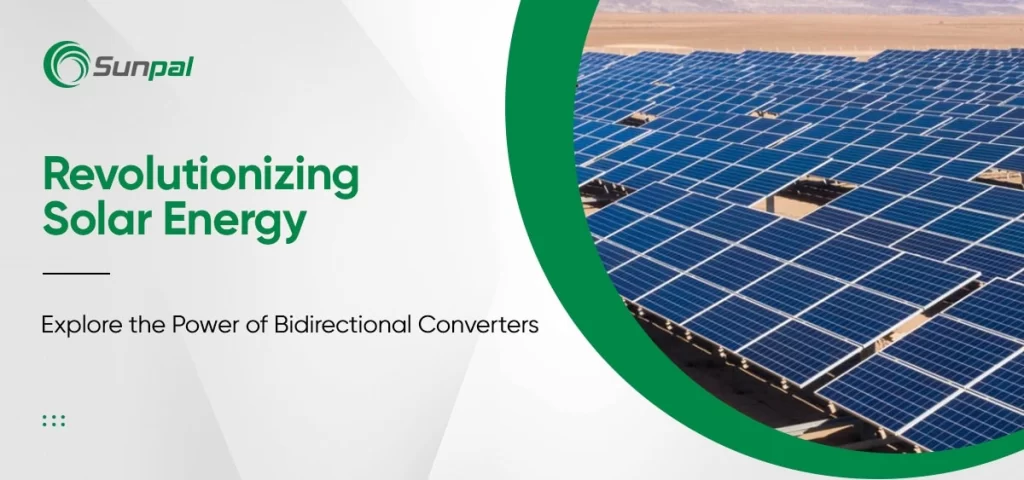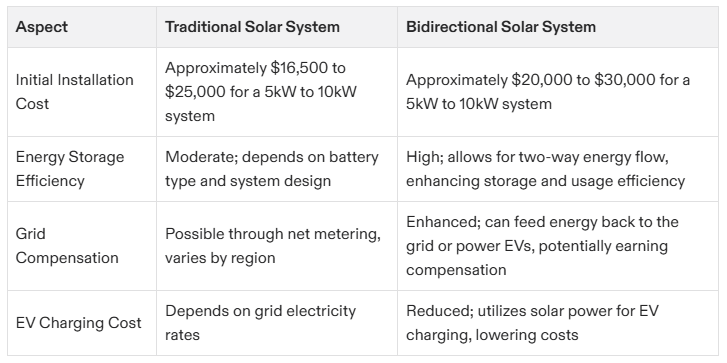
Imagine if your solar energy system could not only power your home but also help power the grid or even charge your electric vehicle. That's exactly what bidirectional converters make possible. In the evolving world of solar energy, bidirectional converters have emerged as a groundbreaking technology that transforms the way we think about energy storage and distribution. While much of the focus has been on AC coupling, DC-side integration and vehicle-to-grid (V2G) applications are now stealing the spotlight. This technology is not just about solar storage, but about creating a dynamic, two-way energy exchange system that allows for more efficient, cost-effective energy management. As electric vehicle (EV) adoption surges, bidirectional converters are poised to play a key role in the future of renewable energy systems.
What is a Bidirectional Solar System Converter?
A bidirectional converter is a specialized inverter technology that enables energy to flow both to and from energy storage systems, making it a game-changer for solar energy storage solutions. Unlike traditional systems, which only convert DC to AC for use in the home, a bidirectional converter allows excess energy to flow back to the grid or to power electric vehicles (EVs) during periods of high demand.
Key Advantages of Bidirectional Converters:
- Two-Way Power Flow: Energy can be stored in batteries or fed back into the grid when solar production exceeds demand.
- Enhanced Grid Stability: Bidirectional converters allow homes or businesses to provide power back to the grid, helping stabilize the electrical grid and support renewable energy integration.
- EV Integration: Bidirectional converters facilitate vehicle-to-grid (V2G) technology, turning your electric vehicle into a mobile energy source that can supply power back to the grid.
The Role of Vehicle-to-Grid (V2G) in Bidirectional Solar Systems
The most exciting application of bidirectional solar converters is the enablement of vehicle-to-grid (V2G) technology. This allows electric vehicles (EVs) to not only consume energy from the grid but also to supply power back to it when needed.
With V2G, the electric vehicle becomes part of a distributed energy network that can provide grid support, especially during high-demand periods. This makes it easier to integrate renewable energy sources, such as solar, into the grid by using EVs as mobile energy storage units.
Benefits of V2G Technology:
- Maximizing Solar Energy Usage: Excess energy generated during the day can be stored in EV batteries, reducing reliance on the grid.
- Grid Support: During peak hours, EVs can feed stored energy back into the grid, providing valuable support during times of high electricity demand.
- Revenue Generation: Owners of bidirectional systems can earn incentives or compensation from energy providers for feeding energy back to the grid.
Chart 1: Power Flow Comparison

The Cost Benefits of Bidirectional Solar Converters
While bidirectional converters offer numerous benefits, their real value lies in the cost savings they provide over time. By enabling solar energy storage, these systems reduce energy bills by optimizing energy use and providing backup power when the grid is down.
Key Cost Savings with Bidirectional Systems:
- Energy Storage Efficiency: Bidirectional systems store excess solar energy during the day for later use, reducing the need to purchase electricity from the grid.
- Grid Compensation: Homeowners can sell excess energy back to the grid during high-demand periods, earning money or credits from their utility company.
- EV Charging Efficiency: Instead of relying on the grid to charge your electric vehicle, the bidirectional system can use solar power, reducing EV charging costs.
Table 1: Cost Comparison of Traditional vs. Bidirectional Systems

Practical Considerations for Implementing Bidirectional Converters
For those considering the installation of bidirectional converters, it's essential to understand the practical steps involved, from choosing the right technology to installation and grid compatibility.
Considerations When Installing Bidirectional Converters:
- Compatibility: Ensure that your solar panels, battery storage, and electric vehicle are compatible with bidirectional technology.
- Regulatory Compliance: Some regions have specific regulations around feeding power back into the grid. Be sure to check with your local utility provider to ensure compliance.
- Installation Process: Depending on the complexity, professional installation may be required to integrate the bidirectional converter with your solar system and EV.
Steps for Installation:
- Choose the appropriate bidirectional inverter for your solar system and EV.
- Install the inverter and integrate it with your energy storage system.
- Connect your electric vehicle to the system for V2G functionality.
- Ensure proper grid connection and regulatory compliance with local authorities.
The Growing Demand for Bidirectional Solar Systems
The integration of electric vehicles with renewable energy systems is one of the most exciting trends in the energy sector. As more people adopt EVs and demand for solar energy systems rises, bidirectional converters are gaining traction as a key solution for energy management.
Why the Surge in Demand?
- Electric Vehicle Adoption: As EV ownership increases, the need for systems that can manage energy flow between vehicles, homes, and the grid becomes critical.
- Renewable Energy Push: With governments and businesses prioritizing sustainable energy solutions, bidirectional systems are viewed as a way to maximize solar energy storage and optimize grid usage.
- Decentralized Energy Networks: The future of energy is decentralized, and bidirectional converters are at the forefront of this shift.
Conclusion: Embracing the Future of Energy with Bidirectional Converters
Bidirectional converters are set to revolutionize the way we manage and distribute solar energy. By enabling vehicle-to-grid (V2G) technology, these systems provide unmatched flexibility, cost savings, and efficiency for solar energy users. As the integration of electric vehicles into the energy landscape accelerates, bidirectional solar converters will play an essential role in driving a more sustainable and resilient energy future.
At Sunpal Energy, we are committed to helping you unlock the full potential of solar energy with innovative solutions like bidirectional solar converters. Whether you’re looking to reduce your energy costs, enhance your grid support capabilities, or integrate your EV with your solar system, our team is here to guide you through every step of the process. For more information on how bidirectional solar systems work, or to explore our range of solar products and services, visit Sunpal Energy today.
